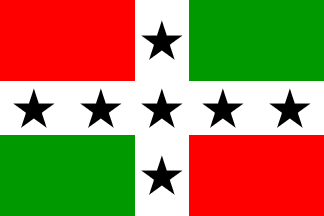 image by António Martins-Tuválkin, 13 July 2008
image by António Martins-Tuválkin, 13 July 2008
Last modified: 2023-01-07 by rob raeside
Keywords: italy | houseflag | house flag |
Links: FOTW homepage |
search |
disclaimer and copyright |
write us |
mirrors
See also:
 image by António Martins-Tuválkin, 13 July 2008
image by António Martins-Tuválkin, 13 July 2008
At the 1940 Spanish source at -www.24flotilla.com-
(fourth of third complete row): House flag of Soc[ietà]
“La Columbia”, Genoa - White cross throughout
defining four fields: upper fields red (hoist) and green (fly),
lower fields green (hoist) and red (fly); on the cross are placed
seven five-pointed stars, five on the horizontal arms and two on
the vertical arms
When compared to the funnel on the left, which is partly black,
the stars seem to be dark blue. This flag with blue stars would
then be a combination of the national colours with the
alternative Italian colour.
According to -oceania.pbwiki.com-
(mostly a place holder, as yet), the complete company name was
‘"La Columbia" Società Marittima per
Trasporto di Petrolio e Derivati’: i.e. “The
Columbian”, Shipping Co. for the Transportation of Oil and
Derivates’.
It is difficult to find coherent information on a firm mentioned
in the 1940 source. On the internet a few tankers are mentioned
for instance ‘Esso Venezia’ (built 1955), ‘Esso
Napoli’ (built 1961), and ‘Pleiades’ (operated
from 1969 on). Luckily a web
file (in Italian) celebrating 115 years of Esso’s
presence in Italy gives the dates: founded 1917 to help with
wartime oil transportation, integrated into Esso Italiana in
1973.
Jan Mertens, 6 March 2008
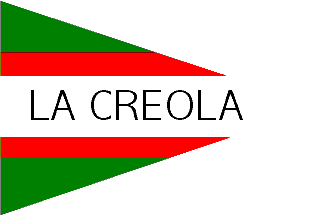 image by Jarig Bakker, 19 February 2005
image by Jarig Bakker, 19 February 2005
La Creola Soc. Anon., Genoa - Green-red-white-red-green
burgee; on white: black "LA CREOLA".
Source: Brown's Flags and Funnels of British and Foreign
Steamship Companies, compiled by F.J.N. Wedge, Glasgow, 1926 [wed26]
Jarig Bakker, 19 February 2005
See also: Alta Italia
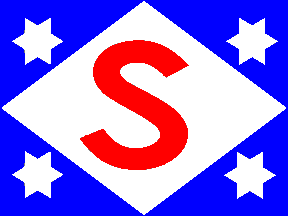 image by Jarig Bakker, 18 December 2004
image by Jarig Bakker, 18 December 2004
Societá Anonima di Navigazione "La Sicania",
Trapani - blue flag, over all white diamond charged with red
"S"; in all corners a white 6-pointed star.
Source: Brown's Flags and Funnels of British and Foreign
Steamship Companies, compiled by F.J.N. Wedge, Glasgow, 1926 [wed26]
Jarig Bakker, 18 December 2004
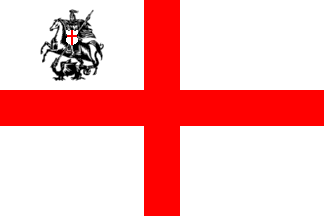 image by Miles Li, 2 July 2016
image by Miles Li, 2 July 2016
The history of this shipping company here (with image of house flag) at -www.theshipslist.com-:
"La Veloce Linea di Navigazione Italiana a Vapore was
founded in 1884 to run services between Italy and South America
(...). The company was taken over in 1883 by M. Bruzzi & Co
who formed La Veloce. (...) The firm of Fratelli Lavarello
(...) was taken over together with their fleet in 1891. In 1900
Italian banks and Navigazione Generale
Italiana commenced buying out German shareholders and by 1901 the company
was effectively controlled by NGI and the official name became La Veloce
Navigazione Italiana a Vapore. La Veloce was absorbed into NGI in 1924 and was
liquidated as a seperate company." A slightly bigger picture (is this St George
slaying the dragon on this Genoan firm's flag?) here: -planeta.terra.com.br-
and lower on the same page, another poster showing it.
Jan Mertens, 22 December 2003
Acording to Mystic Seaport: Lloyd's Book of House Flags and Funnels at -www.mysticseaport.org-,
I believe I can confirm tha this is St George slaying the dragon,
although the design is still rather small (a line drawing, not
coloured). It's flag no. 1249 on p. 61 of chapter "House
Flags and Funnels of Steam Vessels".
Jan Mertens, 22 December 2003
There is a good image
on the Maritime
Timetable Images website, showing a poster dating from
1913. St George and the dragon are quite clear, and
although the drawing is uncoloured the shield has a red cross of
Genoa.
On above poster, other symbols are also shown: the five-pointed
red star as painted on the funnels and the company seal featuring
the house flag.
Jan Mertens, 15 April 2007
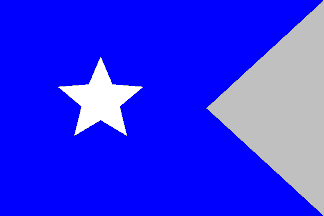 image by Jarig Bakker, 14 July 2004
image by Jarig Bakker, 14 July 2004
From -www.timetableimages.com-:
Flotta Lauro (or Lauro Lines), Naples: a blue swallowtail bearing
a white five-pointed star.
At -planeta.terra.com.br-,
More blue swallowtails here, together with a short history (in
Italian: I understand the firm began business as a cargo shipper
in 1912 and, going bankrupt in 1980, was sold off to the Mediterranean Shipping
Company).
From -paginas.terra.com.br-:
"Il "Comandante" morň nel 1978 e due anni dopo la
Lauro Lines entrň in fallimento. Fu venduta alla MSC (o
Mediterranean Shipping Company che chiamň la flotta acquistata
prima Starlauro e poi Mediterranean Shipping Company",
meaning that two years after the Commander's death in 1978 Lauro
Lines went bankrupt and was sold to MSC which company first
called its acquisition Starlauro and later imposed its own name.
All white stars on these pages, sometimes on a tapering flag
(drawn not photographed).
Jan Mertens, 14 July 2004 and 22 February 2007
Brown (author: F. J. N. Wedge, 1951) [wed51] list this as "Achille
Lauro, Naples".
Jarig Bakker, 14 July 2004
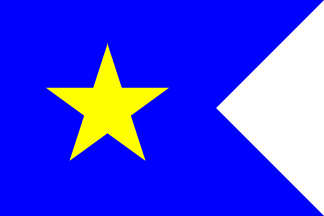 image by Jarig Bakker, 21 February 2007
image by Jarig Bakker, 21 February 2007
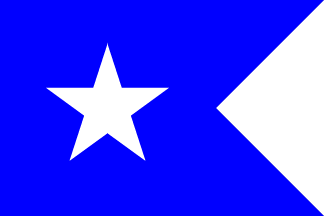 image by Jarig Bakker, 21 February 2007
image by Jarig Bakker, 21 February 2007
Post card collection [] shows a a blue
swallowtail flag with a large yellow star on it. According to -www.simplonpc.co.uk-,
-www.timetableimages.com-
and -paginas.terra.com.br-
(among many other sources on line), this star should be white,
but the star is not dense and much larger than in [wed51].
At -www.simplonpc.co.uk-,
the company logo shows a tappering flagoid. Was it so?
At -www.ssmaritime.com-,
it says that "Lauro Lines merged with the Chandris Line in 1985" and that "in
1987 (…) the Lauro Line became Star Lauro". In our page Jan Mertens says that
the company went "bankrupt in 1980" and "was sold off to the Mediterranean
Shipping Company". At -www.simplonpc.co.uk-,
it says that it was sold "to the Mediterranean Shipping
Company in 1987, with its subsequent renaming as StarLauro, then
MSC". The original company name (or nickname) was apparently
Flotta Lauro.
António Martins-Tuválkin, 21 February 2007
At the 1940 page at -www.24flotilla.com-:
"Achille Lauro", Naples - A different shade of blue
(not significant in this case, I believe) and a white star which
is small and not fat. The swallowtail is indeed not tapered.
Jan Mertens, 8 January 2008
See also: Mediterranean Shipping Company
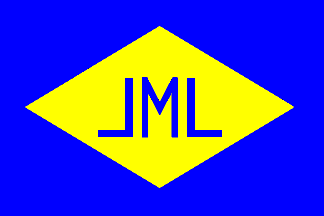 image by Jarig Bakker, 14 July 2004
image by Jarig Bakker, 14 July 2004
From Brown (1951) - Lauro & Montella, Naples - I guess
this is related: blue with a yellow diamond, charged with blue
letters turned L - M - L.
Jarig Bakker, 14 July 2004
 image by Jarig Bakker, 1 September 2005
image by Jarig Bakker, 1 September 2005
Rimorchiatori Laziali S.p.A., Rome - white flag, blue
fly-diagonal; in top hoist blue "R", in fly bottom blue
"L".
Source: Brown's Flags and Funnels Shipping Companies of
the World, compiled by J.L. Loughran, Glasgow, 1995.
Jarig Bakker, 1 September 2005
"Rimorchiatori" are tugboats (in French,
"remorqueurs"). "Laziali" might be the
adjective form of "Lazio", Latium.
Ivan Sache, 2 September 2005
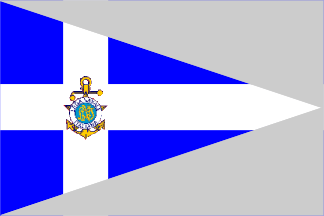 image by Jarig Bakker, 11 July 2004
image by Jarig Bakker, 11 July 2004
.gif)
Emblem
image from -www.lnianzio.org-
From the Maritime Timetable Images, this 1933 poster of the Lega Navale
Italiana -www.timetableimages.com-
showing a flag or pennant with a cross throughout and an emblem centrally on
that cross, featuring a crowned anchor, a star, a fasces, an ornamental letter L
and a band bearing the words 'Mare Nostrum' (Our Sea, as the Romans said).
The flag's field may have been blue and the cross white as in the picture.
Apparently this last entity still exists, only the emblem has understandably
been changed -www.lnianzio.org- with the
words 'Lega Navale Italiana' on the band and ornamental letters
LNI on a disk. Anchor, stars and letters yellow (or gold),
band white with dark blue letters and disk light blue.
As a bonus, what appears to be the LNI's burgee: dark blue
pennant with white cross throughout and the emblem centrally on
the cross (in white, blue and gold).
LNI history (in Italian) at -www.leganavale.it-.
Founded in 1897. Left of text, a 1938 picture
(pennant). This chief site's emblem has gold letters and a
rather dark blue disk.
Jan Mertens, 29 December 2003